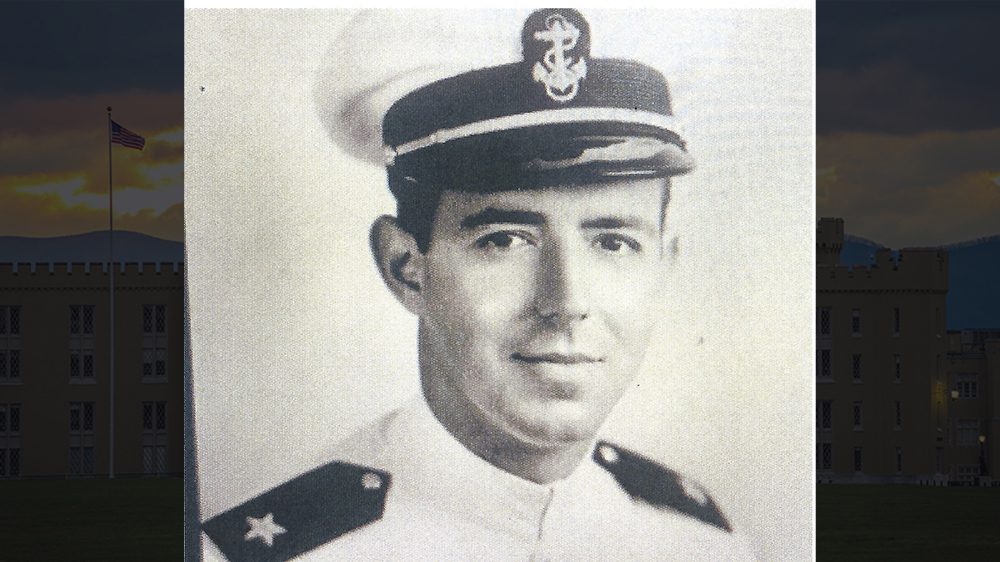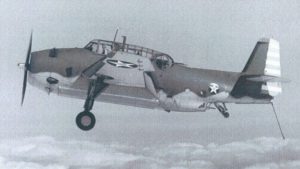Earnest ’938 and the 1942 Battle of Midway

Albert K. “Bert” Earnest ’938 is one of VMI’s most decorated graduates. He was awarded three Navy Crosses during World War II. Photos courtesy VMI Archives.

Albert K. “Bert” Earnest ’938 is one of VMI’s most decorated graduates. He was awarded three Navy Crosses during World War II. Photos courtesy VMI Archives.
Albert Kyle Earnest ’938 is one of the Institute’s most decorated graduates, winning two Navy Crosses in a single day – and later, a third. The first two decorations were awarded for Earnest’s actions as a Navy pilot during the Battle of Midway June 4, 1942.
Earnest’s story began in Virginia. He was born in Richmond in 1917. He followed his brother, Jim ’929, to VMI and was a fun-loving cadet: A 1st Class private.
After VMI, Earnest took a civilian job. He had received a reserve Army commission but soon resigned it and was commissioned in the U.S. Navy Air Corps Reserve. His fleet assignment was with Torpedo Bomber Squadron 8. He reported just days after Pearl Harbor.
He flew the brand-new TBF-1 Avenger, which first saw combat at Midway. There were six TBF-1s stationed at Midway Island, and the remainder of the squadron’s Avengers were aboard the USS Hornet. The U.S. Navy had broken some of the Japanese code and knew the Japanese fleet was headed to Midway.
Entering the battle, Earnest was 25 years old, with no combat hours. With him were Seaman 1st Class Jay Manning and Radioman 3rd Class Harry Ferrier. The Avenger carried one 2,000-pound torpedo in the bomb bay.
On the day of the battle, the Avengers took off from Midway at 4:40 a.m. The enemy was suspected to be 180 miles away.
At 6:55 a.m. Earnest saw what appeared to be the “whole … Japanese Navy.” He was in line with the other five Avengers and they dove, targeting the Japanese carrier Hiryu. Japanese Zero fighters appeared everywhere, firing – too many to count. He tried his .30 caliber machine gun, but it didn’t work. The other two guns were both in action, but Ferrier soon reported Manning was wounded severely or possibly dead. Shortly after, Ferrier was also quiet, and Earnest was alone.

Earnest flew the brand-new TBF-1 Avenger, which first saw combat at Midway
Earnest dove to 200 feet. He could hear bullets hitting the back of his seat. He opened the bomb bay doors. He saw the other five Avengers crash. Shrapnel came in through his windshield, and he felt a wound in his neck. The stick did not work and the cables to the elevator controls were out. He knew his plane could not stay in the air much longer and he could not keep on target to the carrier. Instead, he was heading toward a cruiser and he attempted to drop his 2,000-pound torpedo. Did it release?
He did not know until after the battle, but it did. Earnest’s altitude kept dropping to 100 feet, 75 feet, 50 feet, 25 feet and then 20 feet.
He tried to adjust his trimtabs and remarkably this allowed the aircraft to gain altitude. His rudder worked so he could turn. There were still many enemy aircraft around him. They protected him from the Japanese cruiser, which did not fire at him for fear of hitting their own. Earnest was wounded and had no instruments, no compass and no radio.
He made it to temporary safety in the clouds. He flew east, toward the sun and Midway. If he missed Midway, then Pearl Harbor was the next safe location – 1,200 miles away. He had to find Midway. He finally saw black smoke in the distance. It was Midway.
Earnest still had no radio, Midway had just been bombed and the folks on the ground would be trigger-happy. He recalled a flight path for this situation and followed a prearranged procedure, making necessary turns to alert ground forces to his friendly status. Earnest tried to lower his wheels, but his hydraulics were out. He tried to lower the wheels manually but only one wheel came down. The right wheel was stuck.
He had two options: Land in the lagoon and risk more injury to his crew, or land on one wheel – which is what he did. After he was waved off twice, he came in the third time. He landed with the right wing scraping the ground, sparks flying everywhere. He spun in circles but finally came to a stop. The men on the ground quickly removed the wounded Ferrier, but Manning had died. Earnest was also removed and debriefed. He reported key information for U.S. forces to locate the Japanese fleet.
Of the squadron’s 15 planes, Earnest’s was the only one to return to Midway. One pilot, Ensign George Gay, was plucked from the ocean. He is depicted in the 2019 movie “Midway.” Gay enjoyed the attention and wrote a book, “Sole Survivor,” about his Midway experiences. Earnest often joked that he and Ferrier were the “other sole survivors.”
Torpedo Squadron 8 lost 29 of 32 men who departed from Midway. Earnest received a Navy Cross for dropping his bomb on the Japanese fleet and a second Navy Cross for bringing his aircraft and crew back to Midway. Inspections later found 73 large caliber bullet holes in his aircraft.
The Battle of Midway was the turning point for the war in the Pacific. The Japanese lost 4 carriers and their Pacific expansion was halted. While serving off Guadalcanal during the battle of the Eastern Solomons, Earnest earned a third Navy Cross and was rotated back to the U.S. for the duration of the war.
He continued in the Navy, retiring with 31 years of service in 1972. He had an eventful career, testing enemy aircraft, becoming a “Hurricane Hunter” and qualifying to fly jets.
He died in 2009, and is buried with his wife, Millie, at Arlington Cemetery.
Notifications